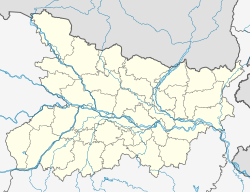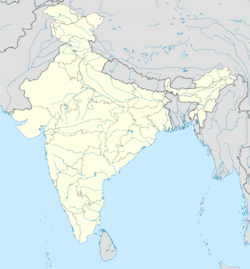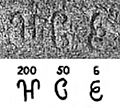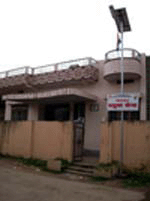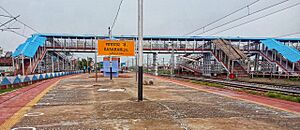Sasaram facts for kids
Quick facts for kids
Sasaram
|
|
|---|---|
|
City
|
|
|
Sher Shah Suri's Tomb, Sasaram
|
|

Location in Sasaram block
|
|
| Country | |
| State | Bihar |
| Division | Patna |
| District | Rohtas |
| Government | |
| • Type | Municipal Corporation (Updated) |
| • Body | Sasaram Municipal Corporation |
| Elevation | 108 m (354 ft) |
| Population
(2020)
|
|
| • Total | 358,283 |
| • Rank | 288th |
| Demonym(s) | Sasaramite |
| Language | |
| • Official | Hindi |
| • Additional official | Urdu |
| • Regional | Bhojpuri |
| Time zone | UTC+5:30 |
| PIN |
821115
|
| Telephone code | 06184 |
| Vehicle registration | BR-24 |
| Railway Station | Sasaram Junction |
Sasaram (), also called Shahasaram, is a city with a rich history in Bihar state, India. It is a municipal corporation area in the Rohtas district.
This city was once the capital of the Sur dynasty in the 1500s. This was when Sher Shah Suri ruled India. Sasaram was also a sub-capital for the ancient king Sahastrabahu.
Sasaram and the nearby Kaimur Range are known for their beautiful waterfalls, lakes, and rivers. Over 200 waterfalls appear during the rainy season!
Today, Sasaram is a large city in Bihar. Many people visit its famous places. These include the Tomb of Sher Shah Suri, which is on a special list for UNESCO World Heritage sites. Other cool spots are the Tomb of Hasan Khan Suri, Rohtasgarh Fort, Shergarh Fort, Manjhar Kund, and Dhua Kund.
Sasaram is also growing as an education center. It is located near towns like Nokha and Kudra, which have many farms and related businesses. The city is the main office for the Rohtas district. This district is known for having the highest number of educated people and the most forest cover in Bihar.
Sasaram is important for making cement, fertilizers, and stone chips. It also has a big quarrying industry. People here mostly speak Bhojpuri, Hindi, English, and Urdu. The main religions are Hinduism and Islam.
Contents
History of Sasaram
In ancient times, Sasaram was part of the old Kashi kingdom. The name Sasaram comes from Sahastrarama, which means "one thousand groves." It was also called Shah Sarai, meaning "Place of the King." This is because it is the birthplace of Sher Shah Suri. He was an Afghan king who ruled over Delhi and much of northern India for five years. He defeated the Mughal Emperor Humayun. Many of Sher Shah Suri's ideas for government were later used by the Mughals and the British. This included how they collected taxes and built roads, like the famous Grand Trunk Road.
Famous Tombs and Forts
Sher Shah Suri's tomb is a huge, 122-foot (37 m) red sandstone building. It stands in the middle of an artificial lake in Sasaram. It looks like the buildings from the Lodhi time. It used to have blue and yellow tiles, showing influence from Iran. The large dome also looks a bit like the Buddhist stupas from the Mauryan period.
The tomb of Sher Shah's father, Hasan Khan Suri, is also in Sasaram. It is in a green field called Sukha Rauza. About one kilometer away is the unfinished tomb of Sher Shah's son, Islam Shah Suri. Sasaram also has a Baulia, which was a pool used by the emperor's wives for bathing.
The Rohtasgarh Fort is another important historical place in Sasaram. This fort is very old, dating back to the 7th century CE. A king named Raja Harishchandra built it for his son, Rohitashwa. Inside the fort, you can find old temples and other buildings from different centuries. Raja Man Singh used this fort as his main office when he was governor of Bihar and Bengal under Emperor Akbar. It's important not to confuse this Rohtas Fort with another one in Pakistan. Sher Shah Suri also built parts of the Rohtas Fort in Sasaram when Humayun was not in India.
There is also a temple for Goddess Tarachandi nearby. Many Hindus come here to worship. Dhua Kund, a beautiful waterfall, is about 15 km (9.3 mi) from the city.
Ashoka's Rock Edict
Sasaram is also known for an ancient inscription by Emperor Ashoka. This inscription is one of his Minor Rock Edicts. You can find it in a small cave on the Kaimur hill, near Chandan Shaheed.
The inscription is located near the top of the Kaimur Range. It is Minor Rock Edict #1. In this edict, Ashoka talks about stone pillars that were already there. He says, "And where there are stone pillars here in my dominion, there also cause it to be engraved." This shows how important these places were even before Ashoka's time.
The Sasaram Edict talks about how Ashoka became a lay-worshipper of Buddhism. He says that even ordinary people can reach "great heaven" if they are dedicated. He wanted everyone, rich or poor, to be zealous and know about his message.
-
The name Jambudīpasi for "India" (Brahmi script) in the Sahasram Minor Rock Edict of Ashoka, circa 250 BCE.
Geography and Climate
Sasaram is located at 24°57′N 84°02′E / 24.95°N 84.03°E and covers about 15 km2 (5.8 sq mi). It is about 110 metres (360 ft) above sea level. The nearby Kaimur Range plateau is higher, around 210 metres (690 ft).
The city is surrounded by hills on two sides. This gives it a pleasant climate with different seasons. Sasaram has a humid subtropical climate, meaning it has relatively high temperatures and rain throughout the year.
| Climate data for Sasaram, India | |||||||||||||
|---|---|---|---|---|---|---|---|---|---|---|---|---|---|
| Month | Jan | Feb | Mar | Apr | May | Jun | Jul | Aug | Sep | Oct | Nov | Dec | Year |
| Mean daily maximum °C (°F) | 23.8 (74.8) |
26.7 (80.1) |
32.7 (90.9) |
38.0 (100.4) |
40.9 (105.6) |
38.5 (101.3) |
33.2 (91.8) |
32.0 (89.6) |
32.4 (90.3) |
31.8 (89.2) |
28.1 (82.6) |
24.1 (75.4) |
31.9 (89.3) |
| Daily mean °C (°F) | 16.2 (61.2) |
18.9 (66.0) |
24.2 (75.6) |
29.6 (85.3) |
33.2 (91.8) |
32.8 (91.0) |
29.2 (84.6) |
28.4 (83.1) |
28.2 (82.8) |
25.9 (78.6) |
20.7 (69.3) |
16.5 (61.7) |
25.3 (77.6) |
| Mean daily minimum °C (°F) | 8.8 (47.8) |
11.1 (52.0) |
15.8 (60.4) |
21.2 (70.2) |
25.5 (77.9) |
27.0 (80.6) |
25.3 (77.5) |
24.8 (76.6) |
23.9 (75.0) |
20.0 (68.0) |
13.3 (55.9) |
8.9 (48.0) |
18.8 (65.8) |
| Average rainfall mm (inches) | 19.2 (0.76) |
21.2 (0.83) |
14.3 (0.56) |
7.6 (0.30) |
12.2 (0.48) |
120.9 (4.76) |
297.5 (11.71) |
326.2 (12.84) |
181.5 (7.15) |
50.9 (2.00) |
10.2 (0.40) |
3.6 (0.14) |
1,065.3 (41.93) |
| Average rainy days | 1.5 | 1.8 | 1.5 | 1.0 | 1.4 | 5.9 | 14.3 | 14.3 | 8.9 | 2.8 | 0.5 | 0.8 | 54.7 |
| Source: Weatherbase | |||||||||||||
People and Population
In 2011, Sasaram had a population of 351,408 people in its urban area. About 52% of the people are male and 48% are female. Sasaram has a good literacy rate of 80.26%, which is higher than the average for India. This means most people can read and write. About 13% of the population is under 6 years old.
| Religions Sasaram City (2020) | ||||
|---|---|---|---|---|
| Hinduism | 72.97% | |||
| Islam | 25.58% | |||
| Sikhism | 1.25% | |||
| Christianity | 0.10% | |||
| Jainism | 0.02% | |||
| Buddhism | 0.01% | |||
| Not Stated | 0.25% | |||
| Distribution of religions | ||||
Sasaram is the 8th largest city in Bihar by population.
How Sasaram is Governed
Sasaram is run by a Municipal Corporation. This group makes decisions about the city's services and development.
Local Government Services
SAHAJ Vasudha Kendra is the first "Common Service Centre" or "eKiosk" in the Rohtas District. It opened in Jamuhar village in 2008. These centers help people access government services online.
Political Representation
Sasaram is one of the 40 parliamentary areas in Bihar. A Member of Parliament (MP) represents Sasaram in the Lok Sabha, which is part of India's national government. Currently, Manoj Kumar (Sasaram politician) is the MP for Sasaram.
Sasaram also has a Vidhan Sabha constituency. This means it has a representative in the state government of Bihar.
Economy and Jobs
Sasaram's economy mostly depends on agriculture. The area is known as "Dhan Ka Katora," meaning "a bowl of food grains," because of its fertile land. Rice grown here is sold in big cities like Kolkata and New Delhi.
The city also has industries related to farming, like rice polishing. A good canal system helps with irrigation. The main industry in Sasaram is rock quarrying, which means digging up stones.
Getting Around Sasaram
Trains
Sasaram Junction station is the main train station. Other smaller stations nearby include Shivsagar and Nokha.
Sasaram station is about 101 km (63 mi) from Pt. Deen Dayal Upadhaya station. It's also about 120 km (75 mi) from Varanasi and 101 km (63 mi) from Gaya. Gaya station is close to Bodh Gaya, a very important place for Buddhism.
Many trains stop at Sasaram, connecting it to major cities like Kolkata, Patna, and New Delhi. Some popular trains include Kalka Mail and Purushottam Express.
Airports
Sasaram has a small, old airport called Suara Airport. For bigger flights, the closest major airports are in Gaya (98 km away), Patna (157 km away), and Varanasi (120 km away).
Education in Sasaram
Sasaram is known for its high literacy rate. Rohtas, the district Sasaram is in, has the highest literacy rate in Bihar.
There are four government colleges in Sasaram. Many students also go to bigger cities like Bangalore or New Delhi for higher education. A new engineering college has also been built here.
Years ago, students used to study at Sasaram Railway junction at night. This was because the city did not have a 24-hour power supply, but the railway station did. This helped students prepare for important exams.
Universities
- Gopal Narayan Singh University
- Veer Kunwar Singh University
Medical Colleges
- Narayan Medical College and Hospital
- Mahatma Phule Medical College and Hospital, Muradabad, Sasaram
- Sher Shah Suri Medical Hospital & Training college, Sasaram
Engineering Colleges
- Shershah Engineering College
Government Colleges
- Shanti Prasad Jain College, Sasaram
- Shri Shankar College, Sasaram
- Sher Shah College, Sasaram
- Rohtas Mahila College, Sasaram
Other Colleges
- Hari Narain Singh Institute of Teachers Education (HNSITE)
- Sri Shankar Rajkiya Inter College
- Government Polytechnic, Dehri, Sasaram
- Jagannath Mishra Law College, Sasaram
Major Schools
- St. Michael's Academy School, Sasaram
- M. P. High School, Sasaram
- Bal Vikas Vidyalaya, Sasaram
- D.A.V. Public school, Sasaram
- St. Paul's School, Sasaram
- St. Xavier's School, Sasaram
Notable People from Sasaram
- Sher Shah Suri: A powerful Emperor of India who defeated the Mughal Emperor Humayun.
- Babu Jagjivan Ram: A former Deputy Prime Minister of India.
- Meira Kumar: The first woman Speaker of the Lok Sabha (India's lower house of Parliament).
- Akash Deep: An Indian cricketer who plays for Royal Challengers Bangalore.
- Kavi Kumar Azad: An actor famous for his role as Dr. Hansraj Hathi in the TV show Taarak Mehta Ka Ooltah Chashmah.
- Jyoti Prakash Nirala: A brave soldier who received the Ashok Chakra, India's highest peacetime military award.
Images for kids



